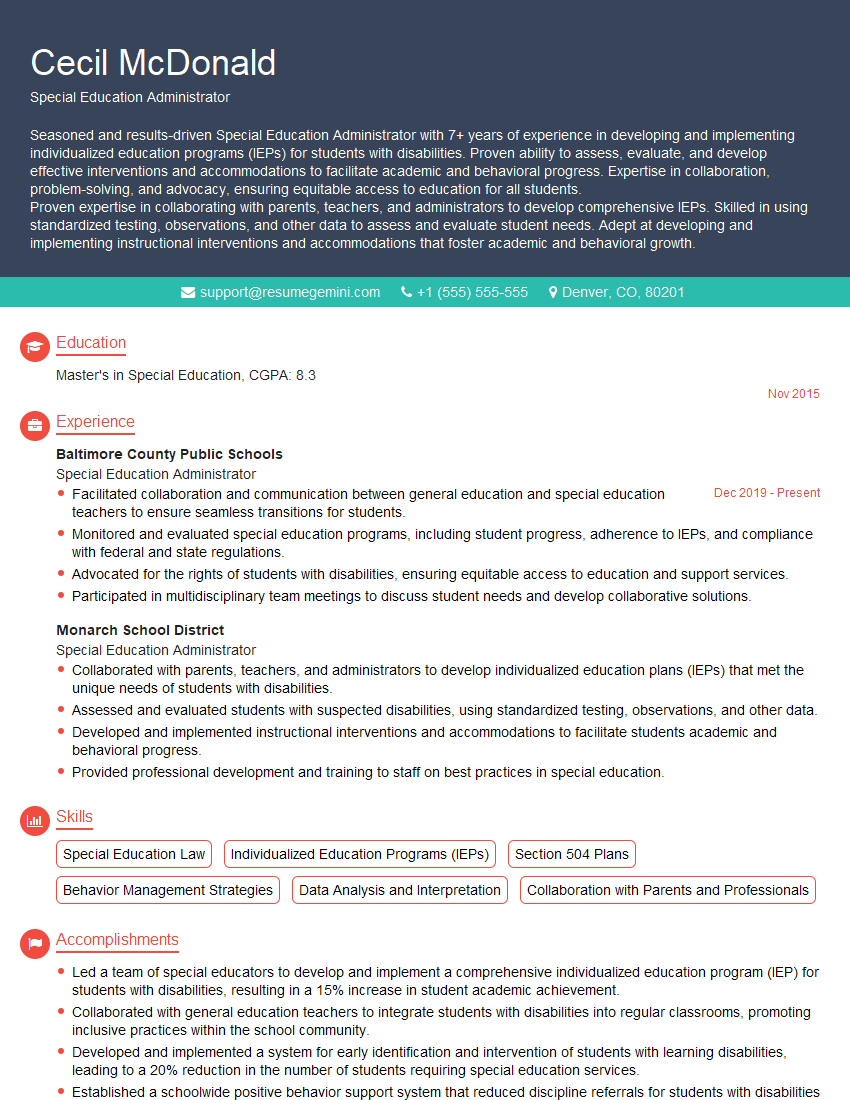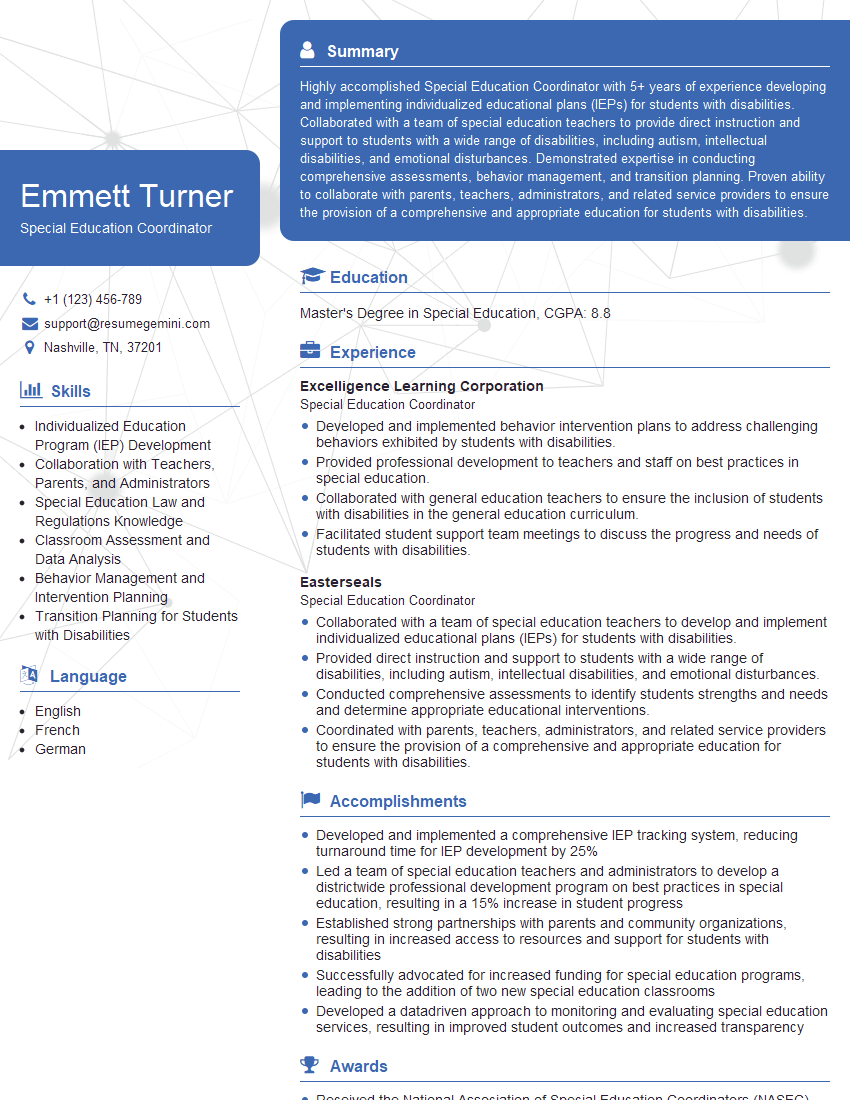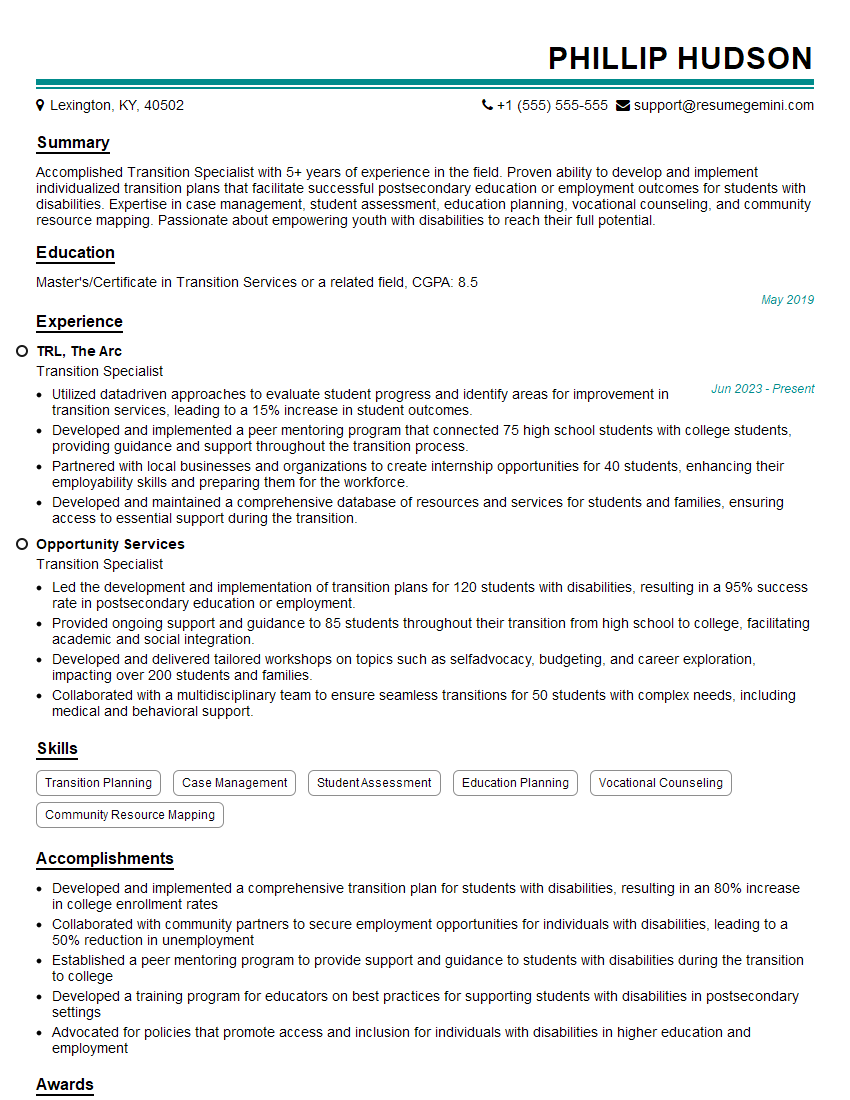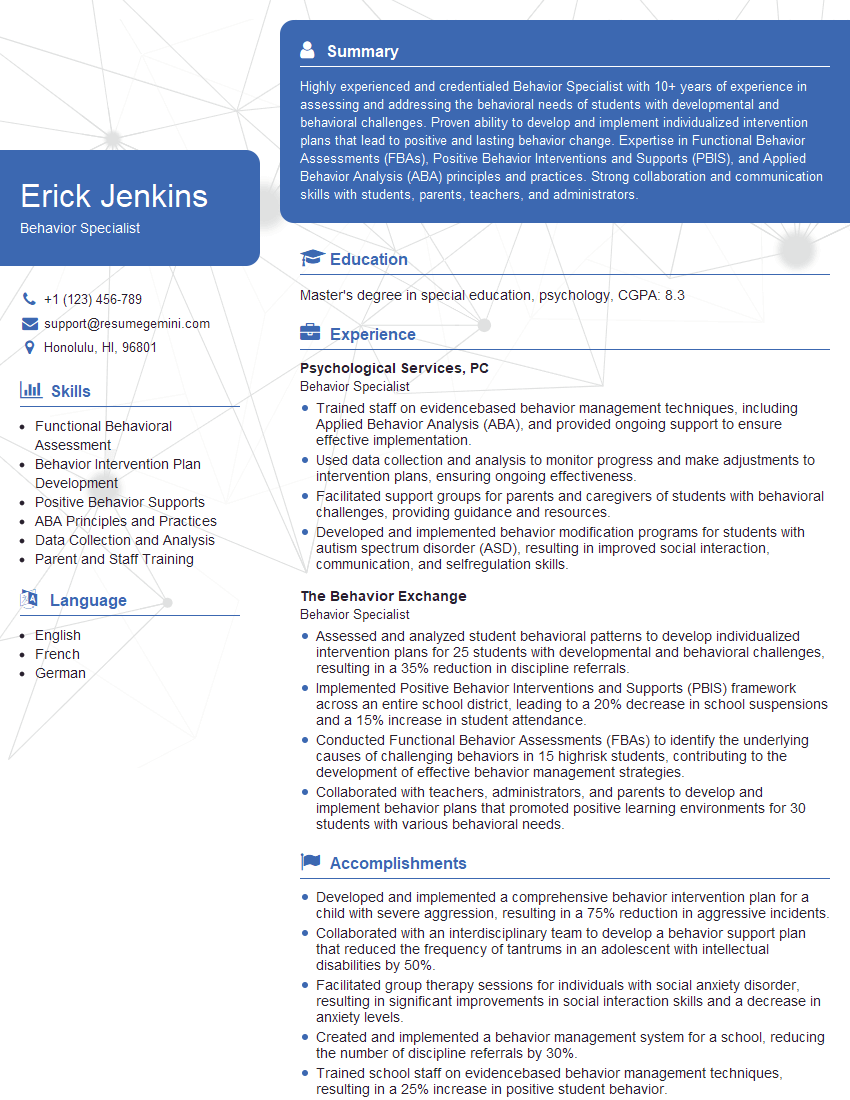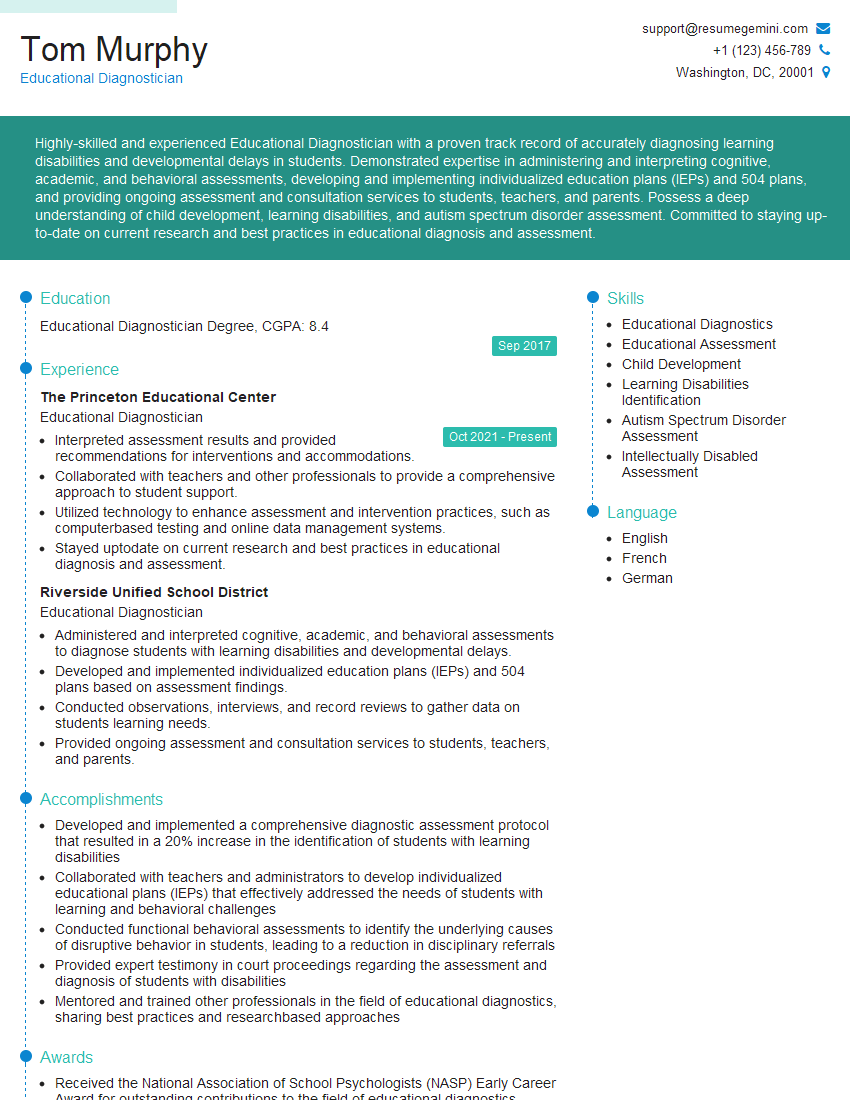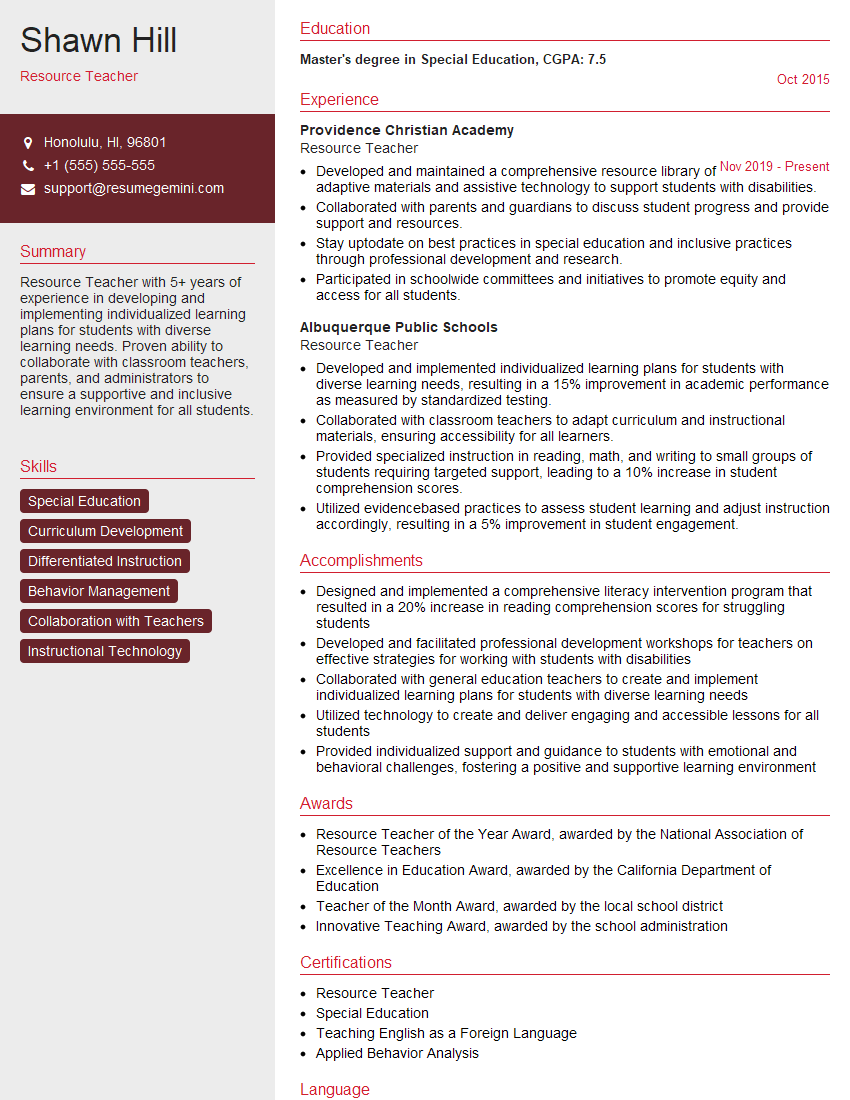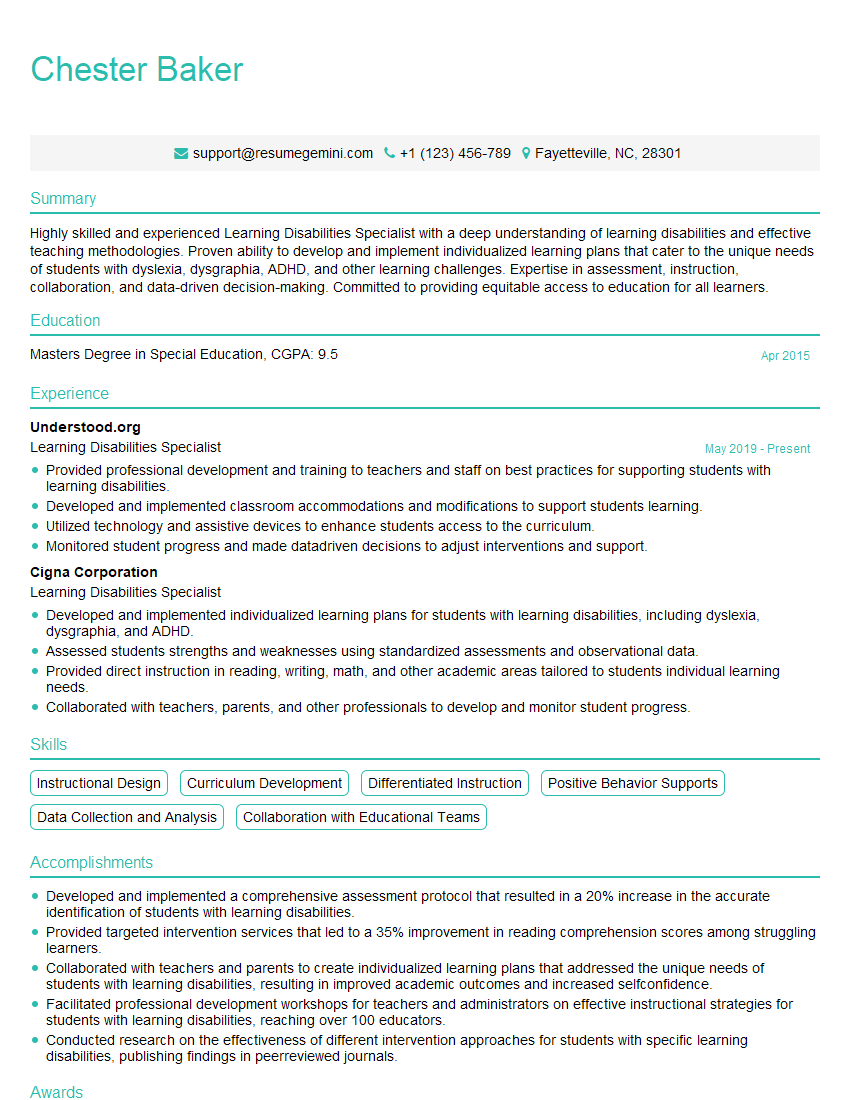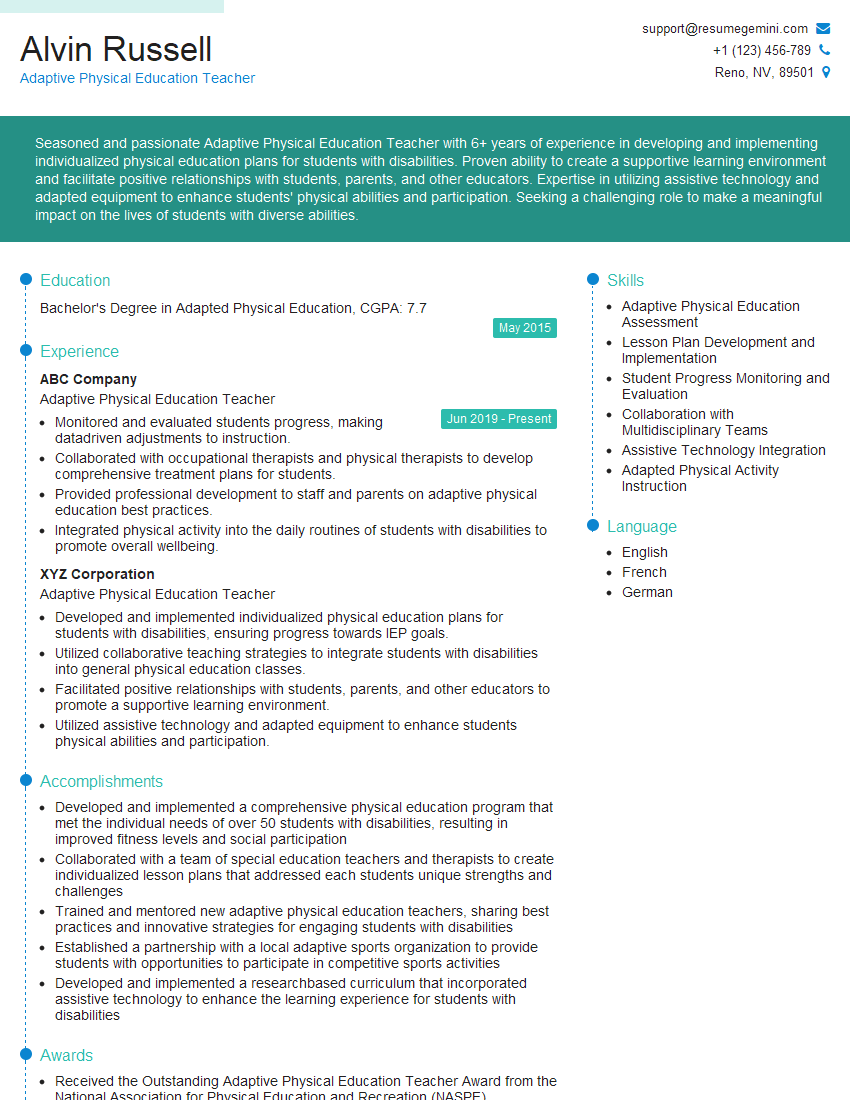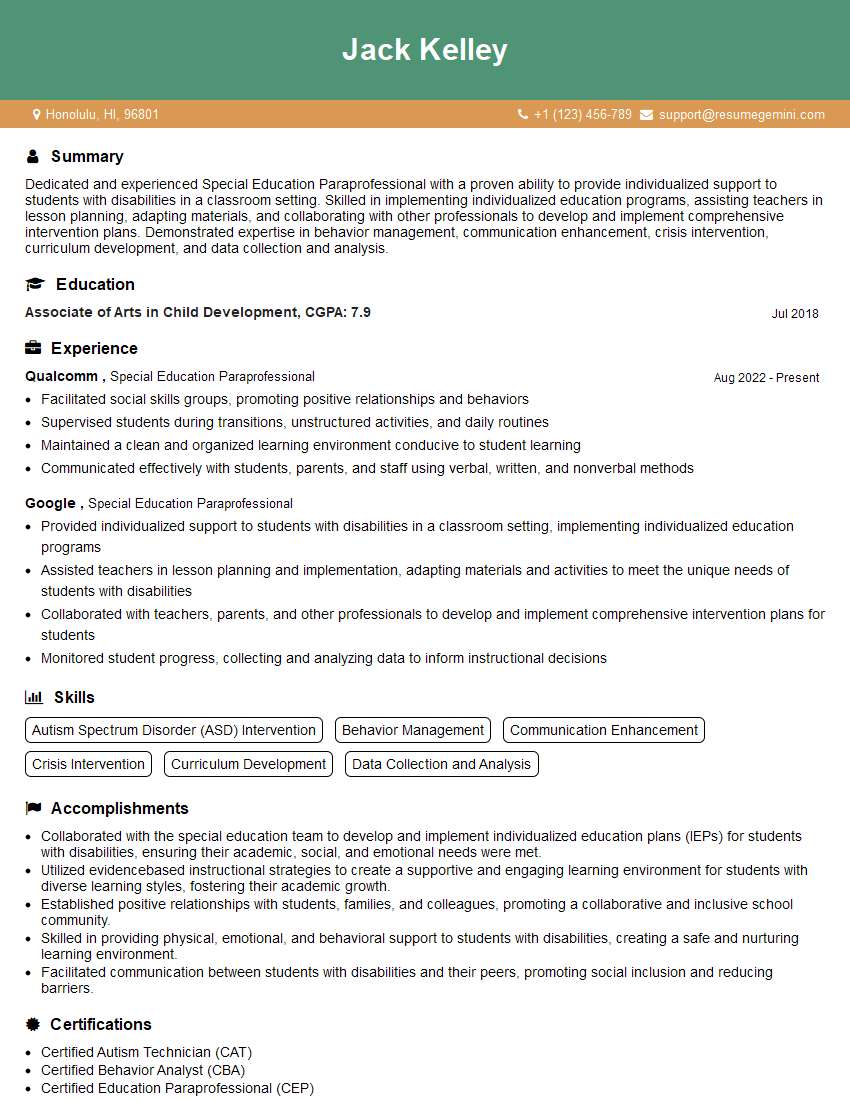Interviews are more than just a Q&A session—they’re a chance to prove your worth. This blog dives into essential Special Education Knowledge and Implementation interview questions and expert tips to help you align your answers with what hiring managers are looking for. Start preparing to shine!
Questions Asked in Special Education Knowledge and Implementation Interview
Q 1. Explain the difference between an IEP and a 504 plan.
Both IEPs and 504 plans help students with disabilities succeed in school, but they differ significantly in their scope and implementation. An Individualized Education Program (IEP) is a legally binding document designed for students with significant disabilities who require specialized instruction and related services to access their education. It’s developed under the Individuals with Disabilities Education Act (IDEA), a federal law. A 504 plan, on the other hand, is developed under Section 504 of the Rehabilitation Act of 1973. It addresses the needs of students with disabilities who don’t require specialized instruction but may need accommodations to participate in general education. Think of it this way: IEPs are for students who need significant changes to their education, while 504 plans are for students who need adjustments to their learning environment.
Key Differences:
- Legal Basis: IEPs are mandated by IDEA; 504 plans are mandated by Section 504.
- Eligibility: IEPs require a formal evaluation process demonstrating significant disability impacting educational performance; 504 plans require documentation of a disability that substantially limits one or more major life activities.
- Services: IEPs provide specialized instruction, related services (speech therapy, occupational therapy, etc.), and significant modifications to the curriculum; 504 plans primarily focus on accommodations and modifications within the general education setting.
- Team Involvement: IEP development involves a multidisciplinary team; 504 plan development generally involves a smaller team.
Q 2. Describe your experience with developing and implementing Individualized Education Programs (IEPs).
Throughout my career, I’ve been extensively involved in developing and implementing IEPs for a diverse range of students. My process begins with a thorough review of the student’s evaluation data, including assessments, observations, and teacher input. I actively collaborate with parents, general education teachers, special education teachers, related service providers (e.g., speech therapists, occupational therapists), and administrators to identify the student’s strengths, weaknesses, and learning needs.
For example, I worked with a student diagnosed with dyslexia. We collaboratively determined that he needed specialized phonics instruction, assistive technology for writing, and extended time on assessments. The IEP detailed specific goals and objectives, strategies for instruction, and methods for monitoring progress. I also ensured that the IEP was regularly reviewed and updated to reflect the student’s progress and evolving needs. Beyond the initial development, implementing the IEP involved providing direct instruction, collaborating with general education teachers to ensure accommodations were implemented effectively, and communicating regularly with parents. Tracking student progress, through data collection and analysis, ensures that the IEP remains relevant and effective.
Q 3. What are the key components of an effective IEP?
An effective IEP comprises several crucial components working together to create a successful learning experience. These include:
- Present Levels of Performance (PLP): A detailed description of the student’s current academic, social, and behavioral functioning. This section forms the foundation for goal setting.
- Goals and Objectives: Measurable, achievable goals that outline specific skills the student will acquire. These are broken down into smaller, manageable objectives.
- Services and Supports: A clear description of the specific special education and related services the student will receive, such as specialized instruction, speech therapy, or occupational therapy.
- Accommodations and Modifications: Strategies and adjustments to the general education curriculum or assessment procedures to ensure student access to learning. This could include extended time on tests, preferential seating, or the use of assistive technology.
- Evaluation and Progress Monitoring: Methods for tracking the student’s progress toward the goals and objectives. This often includes regular data collection and meetings to review progress and make necessary adjustments to the IEP.
- Parent and Student Participation: Active involvement of parents and the student (when appropriate) in the IEP development and implementation process.
Each of these components must be aligned and consistent to create an effective plan. For example, if a goal focuses on improving reading comprehension, the services and accommodations should directly support that goal. Regular monitoring ensures the plan’s efficacy and allows for necessary adjustments.
Q 4. How do you differentiate instruction to meet the diverse needs of students with disabilities?
Differentiating instruction to meet diverse needs is crucial in special education. My approach involves considering multiple factors, including the student’s individual learning style, strengths, weaknesses, and specific disability. I use a variety of strategies, including:
- Tiered Assignments: Providing assignments of varying difficulty levels to cater to different skill levels within the classroom. For example, I might offer a basic, intermediate, and advanced version of the same assignment.
- Flexible Grouping: Using different grouping strategies (individual, small group, whole class) to provide targeted instruction based on student needs. A small group of students struggling with a specific concept might receive extra support while others work independently.
- Assistive Technology: Utilizing technology such as text-to-speech software, graphic organizers, or speech-to-text programs to support students’ learning processes.
- Modified Instructional Materials: Adjusting the content, format, and presentation of instructional materials to enhance student understanding. This may include using simpler language, graphic organizers, or visual aids.
- Universal Design for Learning (UDL): Applying UDL principles to create flexible learning environments and materials that cater to a wide range of learners, minimizing the need for individual accommodations.
For example, I might use graphic organizers for students who struggle with organization, provide visual aids for students with auditory processing difficulties, and offer alternative assessment methods for students with motor skill challenges.
Q 5. What strategies do you use to manage challenging behaviors in the classroom?
Managing challenging behaviors requires a proactive and multifaceted approach. I start by identifying the function of the behavior – what the student is trying to achieve through the behavior. Is it to escape a task, gain attention, or communicate a need? Once the function is understood, I can develop strategies to address it. My strategies include:
- Positive Behavior Interventions and Supports (PBIS): Implementing a school-wide PBIS framework to create a positive and predictable learning environment.
- Functional Behavior Assessment (FBA): Conducting a thorough FBA to understand the antecedents (triggers) and consequences of the challenging behavior.
- Behavior Intervention Plan (BIP): Developing a BIP that outlines specific strategies to prevent and address the challenging behavior. This might include teaching replacement behaviors, providing positive reinforcement, and adjusting the environment.
- Antecedent Modifications: Adjusting the classroom environment or routine to prevent triggering behaviors.
- Consequence Strategies: Implementing consistent and logical consequences for challenging behaviors, focusing on positive reinforcement rather than punishment.
- Collaboration with Parents and Other Professionals: Working closely with parents and other professionals to ensure consistency and support across settings.
For instance, a student exhibiting disruptive behavior during independent work might be seeking attention. An FBA might reveal this, leading to a BIP incorporating strategies like providing frequent positive reinforcement for on-task behavior and teaching the student alternative ways to seek attention appropriately.
Q 6. Describe your experience with various assessment tools used in special education.
My experience encompasses a broad range of assessment tools used in special education, including both formal and informal assessments. Formal assessments include standardized tests like the Woodcock-Johnson IV Tests of Achievement and the Wechsler Intelligence Scale for Children (WISC), which provide norm-referenced data to identify specific areas of strength and weakness. Informal assessments are also crucial, and I utilize various methods, such as:
- Curriculum-Based Measurement (CBM): Regularly assessing student progress on curriculum-based tasks to monitor learning and inform instruction.
- Observations: Observing student behavior and learning in different settings to gather qualitative data.
- Work Samples: Analyzing student work to identify patterns of strengths and weaknesses.
- Teacher-Made Assessments: Designing assessments aligned with specific learning objectives to measure student progress.
- Portfolio Assessments: Collecting samples of student work over time to showcase learning growth.
The choice of assessment tools depends on the specific student’s needs and the information needed to guide instruction and IEP development. I always strive to use a variety of assessment methods to gain a comprehensive understanding of the student’s abilities and challenges.
Q 7. How do you collaborate with parents and other professionals to support students with disabilities?
Collaboration is the cornerstone of effective special education. I prioritize building strong relationships with parents and other professionals to create a supportive and cohesive team focused on student success. My approach includes:
- Open Communication: Maintaining regular communication with parents through email, phone calls, and meetings. I actively solicit parent input and perspectives throughout the IEP process.
- Parent Training and Support: Providing parents with resources and support to help them understand their child’s disability and participate actively in their education.
- Collaborative Meetings: Regularly meeting with the IEP team to discuss student progress, make data-based decisions, and adjust the IEP as needed.
- Co-Teaching and Collaboration with General Education Teachers: Working closely with general education teachers to ensure seamless integration of the student into the general education classroom.
- Professional Development: Continuously seeking professional development opportunities to stay up-to-date on best practices in special education and collaboration.
A collaborative approach ensures that everyone is working together toward a common goal: fostering the student’s academic, social, and emotional growth. For instance, I regularly co-teach with general education teachers to ensure that accommodations outlined in the IEP are effectively implemented and to provide collaborative support to the student.
Q 8. What is your experience with assistive technology and its application in the classroom?
Assistive technology (AT) plays a crucial role in bridging the gap between a student’s needs and their ability to access the curriculum. My experience encompasses a wide range of AT, from low-tech solutions like graphic organizers and adapted writing tools to high-tech devices such as speech-to-text software, text-to-speech software, and augmentative and alternative communication (AAC) systems. I’ve worked with students using screen readers, word prediction software, and specialized keyboards to overcome challenges related to reading, writing, and motor skills. For example, I helped a student with dyslexia significantly improve their reading fluency by utilizing text-to-speech software paired with adjustable font sizes and colors. In another instance, a student with limited fine motor skills benefited greatly from using a voice-activated computer program to complete assignments. My approach always prioritizes assessing individual student needs, selecting appropriate AT, providing thorough training and ongoing support, and integrating it seamlessly into the classroom environment.
Q 9. Explain your understanding of different learning disabilities (e.g., dyslexia, ADHD).
Understanding learning disabilities is paramount to effective special education. Dyslexia, for instance, is a neurological learning difference primarily impacting reading. Students with dyslexia may struggle with phonological awareness (identifying and manipulating sounds in language), decoding (sounding out words), and fluency (reading smoothly and accurately). ADHD (Attention-Deficit/Hyperactivity Disorder) is a neurodevelopmental disorder characterized by inattention, hyperactivity, and impulsivity. Students with ADHD may struggle to focus, follow instructions, and manage their behavior in the classroom. Other learning disabilities, like dysgraphia (writing difficulties) and dyscalculia (math difficulties), also present unique challenges. It’s crucial to remember that these are spectrum disorders; the severity and manifestation of symptoms vary greatly from student to student. Accurate diagnosis through comprehensive evaluations is essential to tailor interventions appropriately. I approach each student individually, considering their strengths and challenges, and collaborate with parents, therapists, and other professionals to develop a holistic support plan.
Q 10. How do you adapt curriculum and instruction to accommodate different learning styles and needs?
Adapting curriculum and instruction is a cornerstone of effective special education. I employ a multi-faceted approach that considers various learning styles (visual, auditory, kinesthetic) and individual needs. This includes differentiating instruction through varied teaching methods, materials, and assessment formats. For example, for a visual learner, I might use graphic organizers, diagrams, and videos; for an auditory learner, I might use audio books and lectures; and for a kinesthetic learner, I might use hands-on activities and manipulatives. I also adjust the complexity and pacing of assignments, breaking down tasks into smaller, more manageable steps. Accommodations, such as extra time for tests, assistive technology, and preferential seating, are also implemented as needed. I frequently incorporate Universal Design for Learning (UDL) principles to create flexible learning environments that cater to the diverse needs of all students. For instance, providing multiple means of representation (different ways of presenting information), action and expression (ways students can demonstrate their learning), and engagement (options for motivating students) ensures inclusivity.
Q 11. Describe your experience with data-driven decision-making in special education.
Data-driven decision-making is essential for ensuring that interventions are effective. I regularly collect and analyze data on student performance, using both formative (ongoing) and summative (end-of-unit) assessments. This data might include results from standardized tests, classroom assignments, observations, and progress monitoring tools. I use this data to track student progress towards goals outlined in their Individualized Education Program (IEP) and make adjustments to instruction as needed. For example, if data shows a student is struggling with a particular skill, I might implement additional support, change instructional strategies, or adjust the difficulty level of assignments. I’m proficient in using data analysis software to visualize trends and identify areas where interventions are most needed. This systematic approach ensures that instruction is targeted, effective, and responsive to the unique needs of each student.
Q 12. How do you monitor student progress and adjust instruction accordingly?
Monitoring student progress is an ongoing process, not a one-time event. I utilize a variety of methods, including frequent informal assessments (e.g., observation during class activities, questioning), formal assessments (e.g., quizzes, tests, projects), and progress-monitoring tools specific to individual goals. These tools help track progress towards IEP goals and allow for timely adjustments. For example, I might use curriculum-based measurement (CBM) to monitor reading fluency or math fact accuracy. If a student’s progress plateaus or shows a decline, I immediately analyze the data to pinpoint the cause. This might involve reviewing instructional strategies, adjusting the level of support, or consulting with other professionals. Regular communication with parents and guardians is vital to keep them informed about their child’s progress and to collaborate on strategies for supporting learning at home.
Q 13. What are some common accommodations and modifications used for students with disabilities?
Accommodations and modifications are crucial for ensuring students with disabilities have equitable access to learning. Accommodations change *how* a student learns the material without altering the content or expectations; modifications change *what* a student learns or the level of expectation. Examples of accommodations include: extra time on tests, preferential seating, use of assistive technology, allowing oral responses instead of written ones, and breaking down tasks into smaller parts. Modifications might include: reducing the number of assignments, simplifying the complexity of assignments, modifying the grading criteria, or providing alternative assignments aligned with the student’s learning needs. The specific accommodations and modifications are always individualized based on the student’s needs and are clearly outlined in their IEP. The choice between an accommodation or a modification is carefully considered to ensure the student is challenged appropriately while still being able to access the curriculum.
Q 14. How do you foster a positive and inclusive classroom environment for students with disabilities?
Creating a positive and inclusive classroom environment for students with disabilities is vital for their academic and social-emotional well-being. This starts with fostering a culture of respect and acceptance where all students feel valued and supported. I employ several strategies: explicit instruction on social skills, peer mentoring programs, collaborative learning activities, and creating a physically accessible and organized learning space. I make a conscious effort to build positive relationships with students, learn about their strengths and interests, and celebrate their accomplishments. Open communication with parents and guardians is crucial for creating a cohesive support system. I also collaborate closely with the school’s special education team to ensure the student’s needs are met. Ultimately, a successful inclusive classroom is one where all students feel a sense of belonging, have opportunities to learn and grow, and are supported to reach their full potential.
Q 15. Describe your experience with crisis intervention strategies.
Crisis intervention in special education requires a calm, proactive, and safety-focused approach. My experience involves implementing de-escalation techniques, utilizing positive behavior support plans (PBSPs), and collaborating with school counselors and administrators.
For example, I’ve successfully de-escalated a student experiencing a meltdown by using a quiet space and providing sensory input, such as weighted blankets. I’ve also worked with students to identify their triggers and develop coping mechanisms, building a strong rapport to prevent future crises. This includes teaching self-regulation strategies like deep breathing exercises and mindfulness techniques. The key is to understand the root cause of the behavior and address it systematically, rather than just managing the symptoms. Collaboration with parents is crucial in developing a consistent approach across home and school environments.
In more severe situations, I’ve been trained in and utilized emergency response protocols, involving contacting appropriate emergency services when necessary and ensuring the safety of all students and staff. I believe that thorough crisis prevention planning, through regular staff training and robust PBSPs, is just as important as effective crisis intervention.
Career Expert Tips:
- Ace those interviews! Prepare effectively by reviewing the Top 50 Most Common Interview Questions on ResumeGemini.
- Navigate your job search with confidence! Explore a wide range of Career Tips on ResumeGemini. Learn about common challenges and recommendations to overcome them.
- Craft the perfect resume! Master the Art of Resume Writing with ResumeGemini’s guide. Showcase your unique qualifications and achievements effectively.
- Don’t miss out on holiday savings! Build your dream resume with ResumeGemini’s ATS optimized templates.
Q 16. What is your understanding of the legal frameworks governing special education (e.g., IDEA)?
The Individuals with Disabilities Education Act (IDEA) is the cornerstone of special education law in the United States. It guarantees free and appropriate public education (FAPE) to all eligible children with disabilities aged 3-21. My understanding of IDEA encompasses its key components:
- Individualized Education Program (IEP): The IEP is a legally binding document outlining a student’s specific educational needs, goals, and services. I’m proficient in IEP development, implementation, and review processes, ensuring they are aligned with IDEA regulations and tailored to each student’s unique needs.
- Least Restrictive Environment (LRE): IDEA mandates that students with disabilities be educated in the least restrictive environment possible, which often means mainstreaming them into general education classrooms with appropriate supports. I’m experienced in determining the best LRE for each student, balancing their needs with inclusive practices.
- Due Process: Parents have the right to challenge IEP decisions through due process hearings. I am familiar with due process procedures and have participated in IEP meetings and hearings, always advocating for the student’s best interests.
- Parental Involvement: IDEA stresses the importance of parental involvement in all aspects of a student’s education. I’m skilled in working collaboratively with parents to create supportive and effective educational plans.
Understanding IDEA is vital for ensuring that students receive the legal rights and services they are entitled to. It’s not just a set of rules, but a framework for ensuring equitable access to quality education for all.
Q 17. How do you ensure the confidentiality of student information?
Confidentiality of student information is paramount. I adhere strictly to the Family Educational Rights and Privacy Act (FERPA) and all relevant school district policies. This includes:
- Secure Storage: All student records, both physical and digital, are stored securely and accessed only by authorized personnel.
- Limited Access: I only share student information with individuals who have a legitimate educational need to know, such as teachers, therapists, and administrators directly involved in the student’s education.
- Password Protection: I utilize strong passwords and secure access protocols to protect digital student records.
- Data Encryption: Where applicable, I utilize data encryption to protect electronic student data.
- Professional Discretion: I exercise careful discretion when discussing student information, even in informal settings.
I regularly participate in professional development trainings to stay updated on best practices for maintaining student confidentiality and data security. Breaches of confidentiality are taken extremely seriously, and I am committed to upholding the highest ethical standards in protecting sensitive student information.
Q 18. Explain your approach to working with students who have emotional or behavioral disorders.
My approach to working with students who have emotional or behavioral disorders (EBD) is multifaceted and rooted in positive behavior support (PBS). I prioritize building strong, trusting relationships based on mutual respect and understanding. This is often the key to unlocking any effective intervention.
Firstly, a thorough functional behavior assessment (FBA) is conducted to understand the function of the challenging behaviors. This involves observing the student, interviewing stakeholders, and analyzing data to identify triggers, antecedents, and consequences of the behavior. Based on the FBA, a behavior intervention plan (BIP) is developed that focuses on teaching replacement behaviors and creating a supportive learning environment.
I utilize a variety of evidence-based strategies, including:
- Positive reinforcement: Rewarding positive behaviors consistently to increase their frequency.
- Skill-building: Teaching students self-regulation skills, such as anger management and conflict resolution.
- Environmental modifications: Adjusting the classroom environment to minimize triggers and support success.
- Collaboration with parents and other professionals: Working as a team to ensure consistency and support across all settings.
For example, I worked with a student who exhibited aggressive behaviors. The FBA revealed that these behaviors were a way to avoid academic tasks that were too challenging. The BIP included breaking down tasks into smaller, more manageable steps, providing frequent positive reinforcement for completed work, and teaching self-calming techniques.
Q 19. How do you support the transition of students with disabilities from school to adulthood?
Supporting the transition of students with disabilities from school to adulthood is a crucial aspect of special education. My approach involves a collaborative, long-term planning process that begins well before the student’s graduation.
I work closely with the student, their family, and other professionals, including vocational rehabilitation counselors and transition specialists, to develop an individualized transition plan (ITP). The ITP outlines the student’s post-secondary goals and identifies the supports and services needed to achieve those goals. This can include:
- Vocational training: Connecting students with vocational training programs to develop job skills.
- Post-secondary education: Assisting students in applying to and attending college or other post-secondary programs.
- Independent living skills: Teaching students life skills necessary for independent living, such as budgeting, cooking, and transportation.
- Community involvement: Connecting students with community resources and opportunities.
- Advocacy training: Empowering students to advocate for their own needs and rights.
Regular monitoring and adjustments are crucial to ensure the ITP remains relevant and effective. This proactive and collaborative approach aims to ensure a smooth and successful transition, enabling students to achieve their full potential as adults.
Q 20. Describe your experience working with students from diverse backgrounds.
Working with students from diverse backgrounds is essential in special education. I believe in creating an inclusive classroom environment that celebrates the unique cultures, languages, and experiences of all students. My approach involves:
- Culturally responsive teaching: Integrating culturally relevant materials and teaching strategies into my lessons.
- Language support: Providing language support services as needed, such as bilingual education or interpreters.
- Family involvement: Engaging families in their child’s education, respecting their cultural values and beliefs.
- Collaboration with community resources: Connecting families with community resources that can support their needs.
- Self-reflection: Continuously evaluating my own biases and practices to ensure cultural sensitivity.
For instance, I’ve successfully adapted my teaching methods to accommodate students’ varied learning styles and cultural backgrounds, working with families to incorporate their cultural perspectives into the learning process. I am always striving to enhance my cultural competence through professional development and by seeking guidance from community leaders and experts.
Q 21. What is your experience with inclusive practices?
Inclusive practices are central to my philosophy of special education. I believe that all students, regardless of their abilities or disabilities, deserve the opportunity to learn and grow in a supportive and welcoming environment.
My experience with inclusive practices includes:
- Co-teaching: Collaborating with general education teachers to plan and deliver instruction in inclusive classrooms.
- Differentiated instruction: Modifying instruction and materials to meet the diverse needs of all learners.
- Universal Design for Learning (UDL): Designing lessons and assessments that are accessible to all students, regardless of their learning styles or disabilities.
- Assistive technology: Utilizing assistive technology to support student learning and access to the curriculum.
- Peer support: Creating opportunities for peer interaction and collaboration to foster social inclusion.
I believe that inclusive education not only benefits students with disabilities but also enriches the learning experience for all students. It fosters a sense of belonging, empathy, and understanding, preparing students to thrive in a diverse world.
Q 22. What professional development activities have you participated in related to special education?
Throughout my career, I’ve actively sought professional development opportunities to enhance my special education expertise. This includes participation in numerous workshops and conferences focusing on evidence-based practices, such as Applied Behavior Analysis (ABA) techniques for managing challenging behaviors and differentiated instruction strategies for diverse learners. I’ve also completed several online courses on topics like assistive technology and inclusive classroom design. For example, a recent workshop on trauma-informed teaching significantly impacted my approach to classroom management and student support. I regularly attend professional learning communities (PLCs) at my school, where we collaborate on best practices and share innovative teaching strategies. Furthermore, I’ve actively pursued advanced certifications, including one in Autism Spectrum Disorder (ASD) interventions, further demonstrating my commitment to ongoing professional growth.
Q 23. How do you utilize different communication methods to engage with students and families?
Effective communication is crucial in special education. I utilize a multi-faceted approach to engage with students and families. With students, I tailor my communication style to their individual needs and learning preferences. For students who struggle with verbal communication, I use visual aids like picture schedules or communication boards. For students who are easily overwhelmed, I break down instructions into smaller, manageable steps. With families, I prioritize open and honest communication. I use a variety of methods including regular phone calls, email updates, parent-teacher conferences, and even informal chats during school events. I also utilize platforms like ClassDojo or SeeSaw to share student progress and keep families informed. For instance, when working with a family whose child has significant communication challenges, I collaborated with a speech therapist and used a visual communication system, regularly updating the parents through photos and videos of the child’s progress using these methods.
Q 24. How do you address the needs of students with multiple disabilities?
Addressing the needs of students with multiple disabilities requires a highly individualized and collaborative approach. It starts with a thorough assessment to identify the student’s strengths and challenges across all domains – physical, cognitive, social-emotional, and communication. This assessment informs the development of an Individualized Education Program (IEP) that outlines specific, measurable, achievable, relevant, and time-bound (SMART) goals. The IEP team, which includes the student’s parents, teachers, specialists, and administrators, collaborates to determine the best support services and accommodations. This might include physical therapy, occupational therapy, speech therapy, assistive technology, and specialized instructional strategies. For example, I worked with a student who had both cerebral palsy and a visual impairment. We created a highly individualized learning environment with adapted materials, assistive technology, and a strong focus on sensory integration techniques. Consistent communication and collaboration with the therapy team and the family were essential for success.
Q 25. Describe your experience with co-teaching or collaborative teaching models.
I have extensive experience with co-teaching models, particularly the one-teach, one-observe and the station teaching models. In the one-teach, one-observe model, one teacher leads the instruction while the other circulates, observing student engagement and providing support. This allows for immediate feedback and adjustments. In the station teaching model, each teacher leads a different learning center, providing differentiated instruction to smaller groups of students. This model allows for targeted support based on individual learning needs. For example, in a co-taught fifth-grade class, my colleague and I used the station teaching method to support students in both math and reading. My colleague focused on explicit math instruction using manipulatives while I facilitated reading comprehension activities in a small group setting. We regularly reviewed student progress and adjusted our stations based on their performance.
Q 26. How do you prioritize student needs in a busy school environment?
Prioritizing student needs in a busy school environment requires effective time management and organizational skills. I use a variety of strategies, including detailed lesson planning, proactive communication with colleagues, and utilizing assistive technology to streamline tasks. I prioritize tasks based on urgency and impact. For example, I dedicate specific time slots for IEP meetings, data analysis, and individual student support. I use a digital calendar and task management system to stay organized and track deadlines. I also proactively communicate with parents and other professionals to ensure seamless collaboration and avoid potential conflicts. Using a system of color-coded folders and digital organization is vital for keeping track of the vast amounts of paperwork that comes with this role. Building strong relationships with colleagues and administrators also provides support and helps in resolving issues efficiently.
Q 27. How do you maintain accurate and organized documentation for IEPs and student files?
Maintaining accurate and organized documentation for IEPs and student files is paramount. I use a combination of digital and paper-based systems to ensure all information is easily accessible and compliant with all regulations. I utilize a secure digital platform, which allows me to track progress, store documents, and easily share information with the IEP team. For paper-based documentation, I maintain a detailed filing system using clearly labeled folders. All documents are meticulously dated and stamped, ensuring complete audit trails. Regularly backing up digital files and ensuring the security of all information is a top priority. For example, I create a checklist for each IEP meeting, ensuring all necessary paperwork and data are readily available. This process ensures consistency, accuracy, and efficient management of student records.
Q 28. What are your salary expectations?
My salary expectations are commensurate with my experience, education, and the demands of this position. I am confident that my skills and expertise align well with the requirements and I am open to discussing this further based on the specifics of the role and the offered compensation package.
Key Topics to Learn for Special Education Knowledge and Implementation Interview
- Individualized Education Programs (IEPs): Understanding the IEP process, including development, implementation, and evaluation. Focus on practical application of legal requirements and collaboration with parents and other professionals.
- Assessment and Evaluation: Familiarize yourself with various assessment methods used to identify learning disabilities and other special needs. Be prepared to discuss the ethical considerations and appropriate use of assessment data in IEP development.
- Differentiated Instruction: Explore various strategies for adapting instruction to meet the diverse needs of students with disabilities. Consider how to modify curriculum, materials, and teaching methods to promote student success.
- Assistive Technology: Develop a strong understanding of different assistive technologies and their applications in the classroom. Be ready to discuss how to select, implement, and evaluate the effectiveness of these technologies for individual students.
- Inclusive Practices: Understand the principles of inclusive education and how to create a supportive and welcoming learning environment for all students, including those with disabilities. Practice explaining your approach to fostering collaboration and participation.
- Behavior Management Strategies: Explore evidence-based strategies for managing challenging behaviors in students with disabilities. Be prepared to discuss positive behavior interventions and supports (PBIS) and functional behavior assessments (FBAs).
- Collaboration and Communication: Understand the importance of effective communication and collaboration with parents, administrators, other educators, and related service providers. Practice describing your collaborative skills and conflict resolution strategies.
- Legal and Ethical Considerations: Familiarize yourself with relevant federal and state laws (e.g., IDEA) impacting special education. Be prepared to discuss ethical considerations related to confidentiality, student rights, and appropriate practices.
Next Steps
Mastering Special Education Knowledge and Implementation is crucial for advancing your career and making a significant impact on the lives of students with disabilities. A strong resume is your first step toward showcasing your expertise and securing your dream role. Creating an ATS-friendly resume is essential to ensuring your application gets noticed. ResumeGemini is a trusted resource to help you craft a professional and impactful resume that highlights your unique skills and experience. Examples of resumes tailored to Special Education Knowledge and Implementation are available to help guide you. Take the next step towards your successful career today!
Explore more articles
Users Rating of Our Blogs
Share Your Experience
We value your feedback! Please rate our content and share your thoughts (optional).
What Readers Say About Our Blog
Hi, I’m Jay, we have a few potential clients that are interested in your services, thought you might be a good fit. I’d love to talk about the details, when do you have time to talk?
Best,
Jay
Founder | CEO

